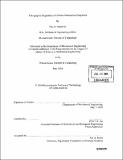Lithograph regulation of cellular mechanical properties c by Tsu-Te Judith Su.
Author(s)
Su, Tsu-Te Judith, 1981-
DownloadFull printable version (5.644Mb)
Other Contributors
Massachusetts Institute of Technology. Dept. of Mechanical Engineering.
Advisor
Peter T.C. So.
Terms of use
Metadata
Show full item recordAbstract
A magnetic trap in combination with two-photon fluorescence microscopy was used to determine the cytoskeletal stiffness and three-dimensional (3D) cytoskeletal structure of NIH 3T3 fibroblast cells plated on micropatterned substrates. Microcontact printing of self-assembled monolayers (SAMs) of alkanethiolates on gold was used to create a planar substrate of islands surrounded by non-adhesive regions. The cells were physically constrained within nanometer high adhesive cylindrical posts of defined size on the surface of a titanium and gold coated coverslip. The islands were coated with the extracellular matrix protein fibronectin (FN) and a protein inhibiter was used to restrict cellular extension. After plating, the cells were fixed and stained with phalloidin. A high-speed, two-photon scanning microscope was used to resolve actin architecture in three dimensions and a fractal dimension measurement was performed to quantify the distribution of actin within the cell as a function of adhesion area. The experiments intend to test the hypothesis that cytoskeletal mechanical properties are a function of cellular adhesion area. We further try to understand these mechanical changes by seeking a con-elation between these mechanical parameters and actin stress fiber distribution. It was discovered that the fractal dimension is a weak inverse function of cell adhesion area but that there is a significant change in fractal dimension between patterned and control cells which can freely spread to their natural dimensions. Microrheological experiments using the magnetic trap show that the mechanical properties of patterned cells are similar within statistical error while significantly softer than the control cells.
Description
Thesis (S.M.)--Massachusetts Institute of Technology, Dept. of Mechanical Engineering, 2004. Includes bibliographical references (leaves 34-36).
Date issued
2004Department
Massachusetts Institute of Technology. Department of Mechanical EngineeringPublisher
Massachusetts Institute of Technology
Keywords
Mechanical Engineering.